Operation Quick Anger Commemoration 2018: After the Battle of Arnhem in September 1944, when the British and U.S. forces failed to cross the Rhine, the northern part of the Netherlands remained under nazi-German occupation. In the spring of 1945, the Western Allies launched a series of military operations to liberate the northern part of the Netherlands, two of them were Operation Quick Anger and Operation Cannonshot, they were conducted in conjunction with each other. Operation Quick Anger was a military operation to seize Arnhem. After the lost Battle of Arnhem in 1944, the residents of Westervoort had already been evacuated. To liberate Arnhem, an enormous Allied military force was gathered at the small village of Westervoort on the east bank of the river IJssel. Operation Quick Anger started on 12 April 1945, the Allies crossed the IJssel from the east at Westervoort. The first troops crossed the river in amphibious vehicles, within 11 hours the Allied forces had constructed a temperory bridge and thousands of military vehicles crossed the river to liberate Arnhem. Arnhem was liberated on 14 April 1945 and within a month the whole of the Netherlands. On 5 May 1945, the nazi-German occupation of the Netherlands had come to an end. The First Canadian Army played a crucial role in the liberation of the northern part of Netherlands. During the liberation of the city of Arnhem in april 1945, the British recorded 62 soldiers killed and 134 wounded, although it is unclear if these figures include Canadian casualties.
In April 2018, we took part in the commemoration of Operation Quick Anger. WWII vehicles and their owners gathered at Vredenburg House in Westervoort for a memorial tour. In our own WWII Ford Jeep, together with other WWII vehicles, we drove through the Liemers, a rural region east of the IJssel. The tour ended at the Crossing to Liberation Monument on the east bank of the river IJssel at Westervoort, where we attended the memorial and wreath-laying ceremony. Since 2011, the memorial ceremony is held at the monument every year to commemorate Operation Quick Anger.
Every year, the Liberation Flame is also lit at the Crossing to Liberation Monument. Every year at midnight on 4 to 5 May, the Liberation Flame is lit in Wageningen, the city where the capitulation documents for all the German forces in the Netherlands were signed in May 1945, the flame is then used to lit torches which are taken by a team of relay runners from Wageningen, the City of Liberation, to more than 200 towns and villages in the Netherlands, Westervoort is one of them.

Operation Quick Anger Commemoration and Memorial Tour 2018: In April 2018, we took part in the memorial tour and attended the memorial ceremony of Operation Quick Anger. Several authentic WWII vehicles and their owners gathered at Vredenburg House in the Dutch village of Westervoort for the memorial tour.
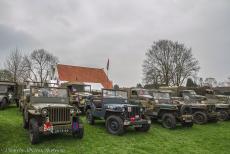
Operation Quick Anger Commemoration and Memorial Tour 2018: In April 2018, we took part in the memorial tour and attended the memorial ceremony of Operation Quick Anger. Several authentic WWII vehicles and their owners gathered at Vredenburg House in the Dutch village of Westervoort for the memorial tour.
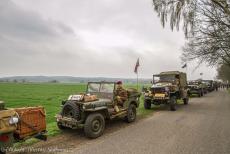
Operation Quick Anger Commemoration and Memorial Tour 2018: Operation Quick Anger was a Western Allied military operation at the end of WWII. Operation Quick Anger started on 12 April 1945 to liberate the city of Arnhem. The Western Allied forces crossed the IJssel from the east at Westervoort. Arnhem was liberated on 14 April 1945.
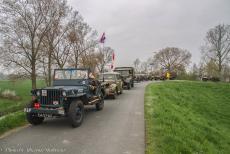
Operation Quick Anger Commemoration and Memorial Tour 2018: In our own WWII Ford GPW Jeep, together with other WWII military vehicles, we drove through the Liemers, a small region east of the IJssel. During WWII each division had its own insignia, carried by all vehicles of the division, the same insignia was also worn by soldiers on the sleeves of their combat uniform.
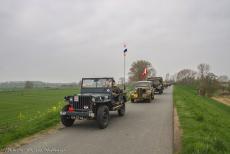
Operation Quick Anger Commemoration and Memorial Tour 2018: A convoy of WWII military vehicles driving on the narrow dyke road between Groessen and Oud-Zevenaar, two villages in the Liemers, a small rural region in the Netherlands, east of the river IJssel. The Operation Quick Anger Memorial Tour commemorates the soldiers who fought for the freedom of our country.
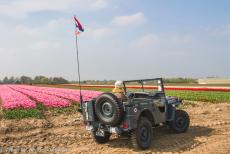
Operation Quick Anger Commemoration and Memorial Tour 2018: A WWII Ford GPW Jeep in front of a tulip field in the Liemers, a small region southeast of Arnhem, situated in the eastern part of the Netherlands between the Dutch-German border and the rivers Lower Rhine, IJssel and Oude IJssel. The Liemers was liberated by the First Canadian Army in april 1945.
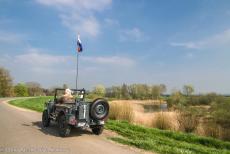
Operation Quick Anger Commemoration and Memorial Tour 2018: A 1942 Ford Jeep on the Ooyse dyke between the Dutch villages of Oud-Zevenaar and Groessen. On the right hand the Rijnstrangen, the dead-end streams and ponds of the Rhine, and the Wejenward, a floodplain area with reeds and pollard willows, both areas are part of the nature reserve Gelderse Poort.
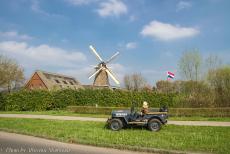
Operation Quick Anger Commemoration and Memorial Tour 2018: A WWII Ford GPW Jeep in front of windmill the Hope in the Dutch village of Oud-Zevenaar. The windmill was constructed in 1850, it was used to grind grain into flour. The mill was damaged in WWII and restored in 1957-1963. Windmil the Hope is still in working condition and sells products to home bakers.

Operation Quick Anger Commemoration and Memorial Tour 2018: The memorial ceremony of Operation Quick Anger at the Crossing to Liberation Monument at Westervoort. In the early spring of 1945, the Western Allied forces launched several military operations to liberate the northern part of the Netherlands, one of them was Operation Quick Anger.

Operation Quick Anger Commemoration and Memorial Tour 2018: The Dutch resistance fighter and WWII veteran Toon Kramer, who also served as an interpreter and translator for the Allies during Operation Quick Anger, gave a speech. The flags of Canada, the Netherlands and Great-Britain were half-staff as a symbol of respect to the fallen soldiers of Operation Quick Anger.
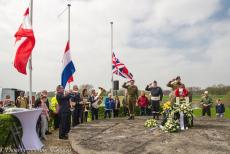
Operation Quick Anger Commemoration and Memorial Tour 2018: The memorial ceremony of Operation Quick Anger at the Crossing to Liberation Monument at Westervoort. Three soldiers salute the national flags of Canada, the Netherlands and Great-Britain during the call of the Last Post, the traditional final salute to fallen soldiers.
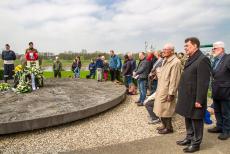
Operation Quick Anger Commemoration and Memorial Tour 2018: The memorial ceremony of Operation Quick Anger at the Crossing to Liberation Monument at Westervoort was attended by the King's Commissioner in the Province of Gelderland, the Mayor of Westervoort, WWII veteran Toon Kramer and descendants of soldiers who were killed during Operation Quick Anger.
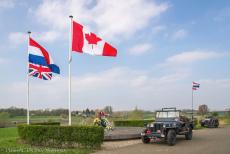
Operation Quick Anger Commemoration and Memorial Tour 2018: A 1942 Ford GPW Jeep in front of the Memorial Crossing to Liberation Monument. The WWII memorial is situated on the bank of the IJssel at Westervoort, it is one of the many WWII monuments on the Liberation Route Europe.
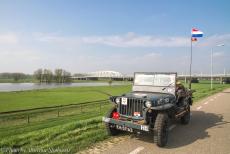
Operation Quick Anger Commemoration and Memorial Tour 2018: Our own WWII Ford Jeep during the Operation Quick Anger Memorial Tour 2018, in the background the bridge across the river IJssel at Westervoort. At the beginning of 1945, the Westervoort bridge was completely destroyed by the Germans. The bridge was rebuilt after WWII.
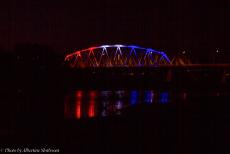
Operation Quick Anger Commemoration 2018: The bridge across the river IJssel at the Dutch village of Westervoort, illuminated with LED lights in the colours of the Dutch national flag. During the WWII commemorations, and some other important occasions, the Westervoort bridge is alluminated every evening from dusk until dawn.
